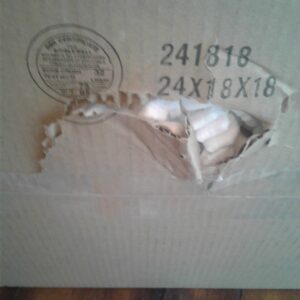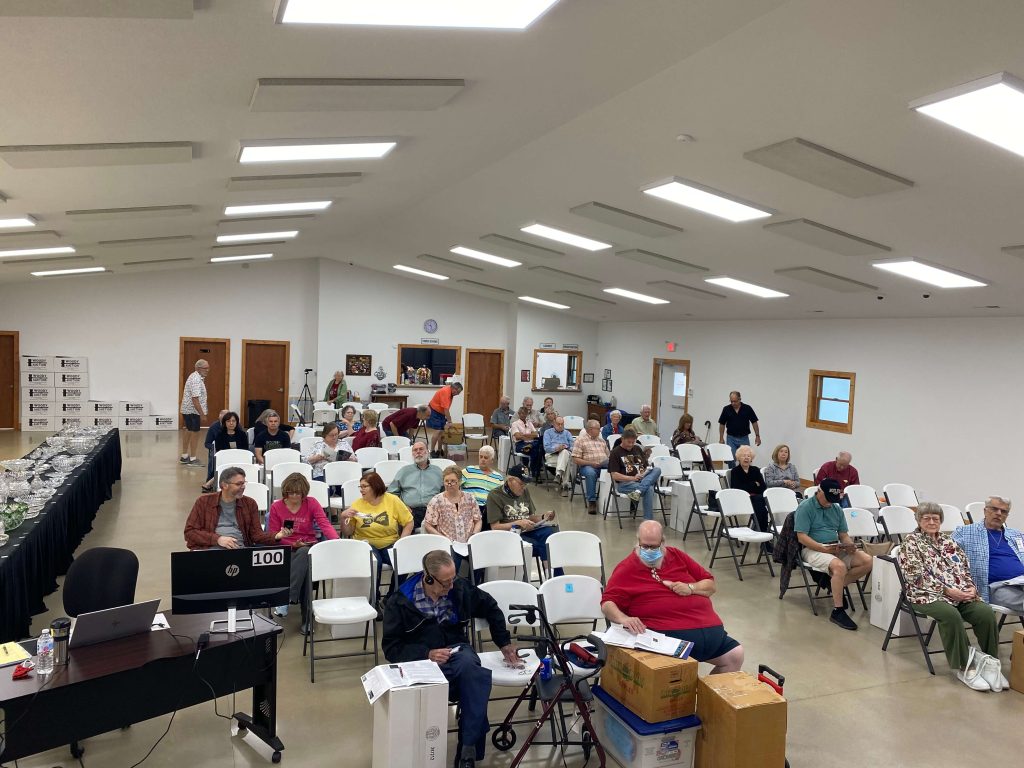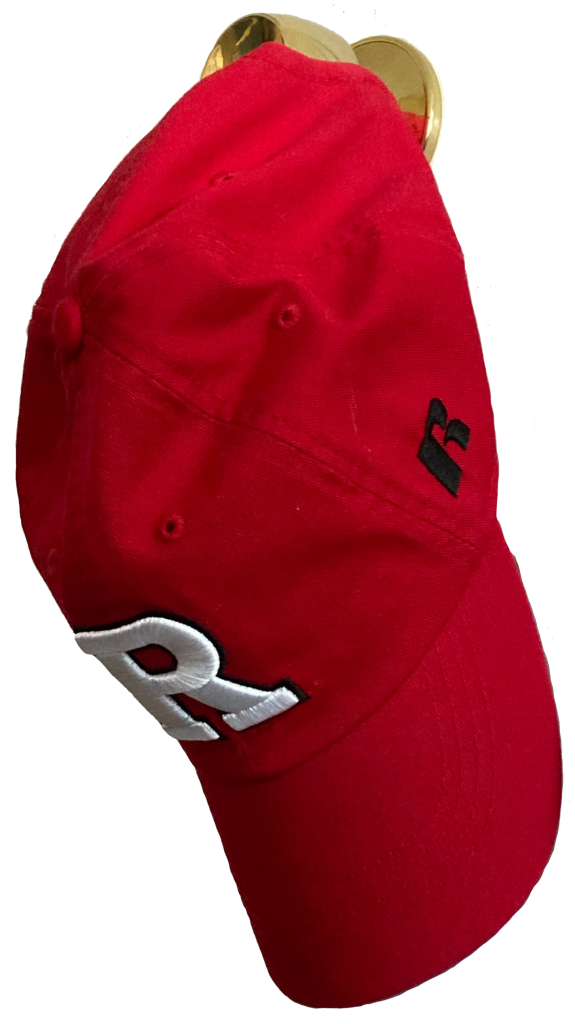
Tiffany Glass
by Laurie Winzer, March 2024
Woody Auction has been blessed to sell many Tiffany items in our history. Some of the many memorable items include a Tiffany Lamp with Nasturtium shade in 2023 ($65,00), a Tiffany Desk Lamp in 2018 ($7000), and a very rare red art glass vase signed L.C. Tiffany-Favrile #5695E in 2014 ($45,000). Having many opportunities in the last few years to examine Tiffany items for condition reports has led me to do some research into the history of these fascination pieces.
Louis Comfort Tiffany was born in 1848. He was the son of Charles Lewis Tiffany who owned a successful jewelry business. Louis chose not to follow his father into the jewelry business as a young man, but rather trained as a painter. He was actually somewhat successful in that career. In 1865, however, a trip to Europe inspired an intense interest in stained glass. He was enamored with the colors of Medieval glass and was convinced that contemporary glass was substandard. At the age of 24 he started studying the art and chemistry of glassmaking.
When Louis first got interested in making glass, he tried his hand at interior design. He was able to use his talent in decorating and in stained glass windows to earn commissions at many well-known homes and churches and even the White House.
Eventually, Tiffany built a glass factory in New York which was incorporated as “Tiffany Glass Company” in 1885 and later became known simply as the “Tiffany Studios”. This is where Louis invented a process of blending different colors and grades of glass together while the glass was in a molten state. This method produced subtle effects of texture and shading. Tiffany named his technique “Favrile”. Some sources attribute the name to Old English and some to Old French, but all seem to agree that the word “Favrile” or “Fabrile” meant “to make by hand”.
Tiffany was very inspired by nature so most of his glass designs reflect that preference. Several types of Tiffany glass are meant to represent an element of nature. Streamer Glass is a type of glass with strings of glass affixed to its surface to depict branches or grass. Fracture glass is a pattern of thin wafers of glass attached in irregular shapes to represent foliage seen from a distance. Ripple glass is a textured glass to represent waves or leaf veins. Drapery glass is a sheet of glass with many heavy folds to represent folds of cloth. These are just a few of the styles of glass that were invented by Tiffany Studios.
Probably the most famous style of Tiffany Glass is known as the copper foil method. For this technique, a pattern was drawn on cardboard with corresponding numbers and glass color written on each section. Each color of glass was placed on its proper section and the pattern for that individual fragment was traced on the glass. Once each piece of colored glass was cut and polished, the copper foil solution was applied to the edges to adhere it to the next section. When all the pieces were put together, the outside edges were soldered. Most often these “puzzle” pieces became very sturdy lampshades or impressive stained glass windows.
In 1893 Louis Tiffany displayed lamps at the world Exposition in Chicago, Illinois which led to his debut in the European market. His popularity in Europe increased over the next few years when a German-French art dealer agreed to serve as Tiffany’s representative. This business relationship lasted into the early 1920s. After that point the Tiffany market began to decline and shortly before Louis Comfort Tiffany passed away, the doors of Tiffany Studios closed in 1930.
Sources used:
https://www.newworldencyclopedia.org/entry/Tiffany_Glass
https://morsemuseum.org/louis-comfort-tiffany/
https://www.metmuseum.org/toah/hd/tiff/hd_tiff.htm
https://www.dailyartmagazine.com/tiffany-glass/
Terminology
by Laurie Winzer, December 2023
One of the jobs I have at Woody auction is to provide condition reports for potential bidders. During the process of learning how to examine an item and jot down any damage, flaws, or anomalies I find, I’ve discovered that antique collectors have their own jargon for describing various types of factory flaws or damage. I try as much as possible to use that same terminology in my condition reports so that I’m giving consistent reports to everyone. Sometimes, though, it is difficult to describe a particular condition occurrence to a newer collector because they don’t understand the term I’m using. They also don’t know whether I’m describing a factory flaw that is not considered damage or actual damage to the piece. I thought it might be helpful to provide a list of some of the terminology we use for identifying damage or factory flaws at Woody Auction.
Flea Bites –pin-head size or smaller glass losses which can usually be detected with a fingernail or magnifying glass; these are generally not reported in our condition description.
Nick – slightly bigger than a flea bite but not of significant size to call in our condition description.
Chip – bigger than a nick; these are considered significant enough to be called on our condition description.
Scuff – scratches or rubs on the glass usually caused by normal use
Crack – a fracture that is highly visible and refracts light
Hairline –small, tight crack that does not go through to the other side of the item (this terminology is only used for porcelain)
Crows feet – short hairlines that fan out in several directions (this terminology is only used for porcelain)
Bruise – when a piece of glass gets hit, but does not result in glass loss – you can usually visibly see the damage but not necessarily feel it
Ash Mark – when a bit of ash is embedded in the glass during manufacturing
Cooling Mark - String-like inclusions in glass caused as the hot glass cools. Often called “straw marks.”
Crazing – Crazing is a glaze defect of glazed pottery characterized as a spider web pattern of cracks penetrating the glaze; it is caused by tensile stresses greater than the glaze is able to withstand.
Inclusions – When tiny air bubbles get trapped inside the glass during manufacturing.
Sand Deposit - Small included piece of sand remaining from the manufacturing process. May look like bits of sand or a small stone. (Sometimes called a stone inclusion or a stone dog.)
Round Pontil Mark - Circular, slightly rough mark on the bottom of an item, caused by the removal of the item from the glass blowing rod. Found on blown and blown-mold items.
Rough Pontil Mark - Raised, sometimes sharp, mark or scar on the bottom of a blown glass item, caused by the removal of the item from the glass blowing rod. Often appears as a small glob on the bottom of an item.
Shear Mark or Straw Mark - Straight mark or scar caused by the shears used to cut away the molten glass as it was being dropped into the mold. Sometimes called a “straw mark”.
Straw Mark – a string-like line that happens in the glass during cooling (often used interchangeably with “shear mark” or “cool mark”.
Tool Mark – when the cutting machine leaves one or more tiny, very straight cuts in a piece of cut glass
Open Bubble or Inclusion – a bubble close to the surface that has broken open
For more information please see the following websites:
https://www.chaletvintageartglass.ca/articles/c64rd7la48brqk0ssbxodi20j0fbmb
https://www.carnivalglassworldwide.com/shear-marks.html
https://www.collectorsweekly.com/stories/102068-cooling-marks--appearances-can-be-decei
https://www.antiquepeek.com/facts_porcelain_terms.htm
Adjustments
by Laurie Winzer, September 29, 2022
In every business there comes a point when a company pauses and re-evaluates procedures due to economic issues outside of its control. No one wants to do this, but it’s a necessity based on the harsh reality of inflation.
Because of this procedural review, we have made some adjustments in the way we receive payments. Effective March 1, 2023, on all future automated Online Only auctions, each winning bidder will need to click the CHECK OUT button in order to pay for their items. We would like to offer a brief explanation of what was considered when making this change.
Our first reason is the volume of workload we are currently experiencing. When we have an online only auction that generates 220 invoices, it is labor intensive to deal with all the forms of payment we have previously accepted. Instead of increasing Buyer’s Premiums or commissions significantly during this time of inflation, we opted to institute this new policy. As you know, we have a very small staff to accomplish all that we do. This change will speed everything up, thus freeing us to do our other many tasks.
Our second basis for changing the policy is the sheer number of bidders who pay by check but don't get it to us until three-plus weeks after the auction. When we've quoted a price that must be paid by the 10th day post-auction, and the mail is slow or people pay late, it makes us less effective. Our office space is limited and when we have auctions every two weeks, we must keep boxes moving out. The late payers usually have 6-8 boxes each, and we are struggling with starting the next scheduled auction process when our office still has leftover boxes from the previous auction. We are hoping to minimize this situation.
Our third reason is our own rising expenses. We recently received a letter from our cleaning company, raising their rates 40%. We also received rate increases from the auction platform we use to provide online auction services, our insurance company, and our alarm system provider (to name a few). Every area of our business has seen increases and we want to continue offering antiques for many years. We wish inflation weren't what it is, but the reality is that it will be difficult to keep offering the high-quality antiques we do without some adjustments.
We hope that you will graciously understand our decision and continue to support our business so we can continue to serve you for as long as possible. Thank you so much for being loyal customers. We truly do appreciate you!
We Shed Tears
by Laurie Winzer, September 29, 2022















We receive many boxes containing antique glass that a consignor has asked us to auction for them. Once in a while those packages come in so damaged that we're afraid to open them. We cringe as we pull out broken pieces of glass. It makes us want to weep because they’re valuable historical pieces – lost forever.
After seeing so many of those boxes of broken glass, I decided to give you a rough idea of how your package will be handled as it makes its way across the country and sometimes from international locations, too. I would also like to share with you some tips on packing your glass to ship to us.
Keep in mind when you are wrapping and boxing your precious items that they will not be traveling in a stationary position but will be shifted from one shipping container or vehicle to another. The box will be handled by many different people and many different sorting machines. It will be jostled as it travels many miles in heavy duty vehicles driving on various conditions of roads.
When your box is first picked up by a shipping company it bounces along in a truck to the nearest sorting station. Then workers will unload your box from the truck to a conveyor belt sorting system where it will bump up against other packages and slide down to other levels until it's loaded into the next transportation vehicle. At this point the box might end up on a plane or a semi-truck depending on how far it needs to travel to its next destination. When it arrives the box will once again be unloaded and moved to a conveyor belt sorting system to be moved onto the next form of transportation, which might involve another cross-country jaunt or possibly a local truck for delivery. All of these steps mean lots of miles of travels and a lot of handling by many different people.
While researching I discovered a website with some comments from former shipping company drivers who had some advice to offer people wrapping and packing items to be shipped. One person reminded us that most of the sorting is done by machine and machines can't read "FRAGILE" or "THIS SIDE UP" stickers. He suggested that you wrap and box your item in such a way that you could push your package off a counter onto a hard-surface floor without causing any damage inside or out. Another person cautioned that even though shipping workers try to be careful, they are all under timeline crunches so packages will often get tossed around more than they ought. They also don't have time to pay attention to weight of packages so a heavier package might end up sitting on top of a lighter one.
That's why it's so very important to wrap your antique glass items with extra layers and greater care. When Woody Auction wraps items for shipping we use a layer of tissue, a layer of paper, and then a layer (or sometimes two) of bubble wrap. We also use only masking tape to secure the bubble wrap. Clear tapes are very difficult to remove from bubble wrap and can lead to damaging item while trying to unwrap. We carefully nestle the bubble wrapped item(s) in a box with 2 inches of peanuts between items and around the edges of the box. For higher value items we place that box into a larger box with a layer of peanuts all around.
For more information on how you can best wrap your antique glass, here's a link to our wrapping demonstration video. I hope this information will be helpful to you when you get ready to ship your antique glass to us. We never want to see historical items broken!
Fun Fact: UPS reports that their WorldPort shipping hub in Louisville, KY has over 155 miles of conveyor belt.
Fun Fact: The FedEx logo has an arrow hidden in the space between the E and the x
Google Review regarding Woody Auction packing: "The in-house shipping team exceeded all my expectations. Items were so carefully packaged they could have been dropped off a building!" (Lisa S.)
If you would like more information, you can visit the following links:
https://www.quora.com/Do-shipping-carriers-like-USPS-take-more-care-handling-packages-with-fragile-stickers
https://www.11alive.com/article/news/local/verify/verify-do-fragile-labels-protect-your-packages/85-df96f12f-8672-4019-ba09-f44f1381b5f8
https://uk.worldoptions.com/news/5-facts-about-fedex
https://uk.worldoptions.com/news/5-facts-about-ups
To watch a video on the UPS shipping system, click here.
Daum Nancy Glass
By Laurie Winzer, April 19, 2022
In 1878 a lawyer named Jean Daum took over a glass factory near Nancy, France as partial payment of a debt owed him. At that time, the company mostly made utilitarian glassware and glass for watches and windows. Jean's son, Auguste, originally helped him get the factory in working order. Auguste's brother, Antonin, joined the company several years after his father died.
The two brothers combined their creativity and engineering precision to shift the company away from utilitarian items to stunning art glass designs. They put their own spin on a style called "Cameo" – instead of carving a low relief decoration into multiple layers of glass, they created enamel designs (to make a raised pattern by using paint or another substance) or intaglio (to make a raised pattern by carving around it). Sometimes they used acid to etch a pattern. On other pieces they would shape colored glass over a molten hot piece of glass and then carve or etch a design after it was cooled. Much of the work the Daum brothers did was inspired by Émile Gallé.
During World War I the brothers suspended the art glass production and concentrated on producing medical glass to support the war effort. Once the war was over and art glass production recommenced, the company shifted from Art Nouveau glass to Art Déco glass. This new style was introduced by Paul Daum, the son of Auguste. Everything was less delicate and had less floral design. The patterns were more simplistic but bolder with geometric shapes and bright colors. This type of glass lasted from roughly 1918 until around 1945 when production changed direction again to heavy, lead crystal.
The leaded crystal produced by Daum Nancy was of exceptionally high quality and highlighted the graceful qualities of clear glass. It was heavy and had no surface decoration unlike the previous eras of carving, etching, and other relief patterns. The crystal production lasted until somewhere between the 1965s to 1970 when the next generation of Daums took over.
In the 1970s the Daum family decided to reintroduce a style of glass production called pâte-de-verre. This is a process where glass is crushed, mixed with a binding agent, and reshaped into something new. The Daum Nancy company invited glass artists, sculptors, and designers to design some limited-edition glass items for them. Many famous artists and sculptors participated including Salvador Dalí and César. The company experienced quite a bit of success from this tactic.
The most common form of Daum Nancy signature is the name "Daum Nancy" with the cross of Lorraine incorporated somewhere. The usual company policy was not to have individual artist signatures, but there were exceptions. There was a second factory opened in 1927 and run by Pierre D'Avesn that produced glass designed to compete with Lalique, which was signed "P. d'Avesn" or "Lorrain" or "Val". Occasionally some of that same glass was produced in the original factory under the signature "Verreries de Belle-Etoile".
Daum has had a tremendous influence on the art glass world spanning not only four major styles of glass but also many generations of the Daum family. Their legacy continues even in our modern world.
Bohemian Art Glass
by Laurie Winzer, 01/27/2022
The past few auctions have had quite a few Bohemian Art Glass items. Since I wrapped a lot of it, I got curious – what is this type of glass and where did it come from?
Bohemian glass has been around since the 13th century and comes from the former country of Bohemia which is now part of the Czech Republic. This region is ideal for creating glass since it has copious amounts of silica, chalk, and potash. During this time, most of the glass was made by Benedictine monks and used for stained glass windows. Bohemian glass didn't become highly sought after until the 17th century when a gem cutter named Caspar Lehmann perfected a technique for cutting glass. This technique worked well with the new invention of potash-lime glass which was heavy and had a high luster. Not only did Lehmann perfect the technique for cutting glass, but he also discovered a way to overlay one color of glass with another so that when cut, the under color would show through. After that, the Bohemian glass industry exploded in popularity and Bohemia became the leading producer of high-quality glassware. They even changed their terminology from "glass" to "crystal" in order to separate themselves from other suppliers in the same industry.
For most of the 18th century Bohemian glass became as much of a luxury item as jewelry and led to more opulent productions of cups, goblets, pitchers, and even elaborate chandeliers. Much of the glass from that time period has gold embellishments. Toward the end of the 18th century, however, demand for these luxurious crystal products began to drop, so producers turned their attention to supplying middle class consumers. They began to furnish a fuller range of tableware, but in a much simpler, more practical design and production once again flourished.
During the last half of the 19th century, production began to move toward a more artistic style. Most of the same techniques for producing, stylizing, and/or cutting glass were used, but producers took a more modern approach and treated their glass techniques more like art and less like useful pieces. They experimented with layering and swirling glasses at different stages of manufacturing, as well as color layering. Producers such as Lobmeyer, Moser, Loetz, and Kralik became well known. Since these producers were all from the same time period and were using similar techniques it's sometimes difficult for a lay person to distinguish one piece from another. That's why it's so important to have a piece evaluated by an expert before buying or selling it. It's been fascinating for me to listen to conversations between Jason and his mother, LaVeta, as they identify different makers of some of the Bohemian Art Glass pieces they're examining. I'm looking forward to our next two Bohemian glass auctions on January 29, 2022 and June 11, 2022.
The Buying and Selling Process
11/29/2021
Many people may not know Woody Auction or the history and reputation that has been built over three generations of Woody auctioneers. Milton Woody started as an impromptu auctioneer at a local church function which evolved into conducting auctions for the local farmers. Then John Woody stepped in during the early 60’s and quickly grabbed national attention for selling quality antiques with a “no nonsense” approach of selling everything without reserve and never allowing owners or employees to bid. Jason Woody took over for his father, John, in the early 2000's.
The method of auctioning has remained much the same, but the presence of Online Auctions has really changed the overall “dynamics” from an auctioneer's perspective. Gone are the days when 200 people would show up to an auction to conduct their bidding in person. We now have auctions where 1,000 people are attending online from all over the country (and the world!) Many people still attend in person as well. As always, the highest bidder will win the item being sold, but the dynamics of seeing just a small gathering of individuals in the room who are competing against the hundreds of online bidders has been a big learning adjustment as an auctioneer.
To become a bidder, a person simply needs to use one of the following three options: (1) attend the auction, register for a bidder card using your driver's license, and try to become the highest bidder on your desired item. There is no buyer’s fee for people who attend in person and pay by cash or check; (2) leave an absentee bid (preferably by email or fax) and let Woody Auction bid against the competition until either you win the item or are outbid. (There is a buyer's premium for absentee bidding); or (3) register via LiveAuctioneers.com, bid on the computer before the auction or bid live during the auction to try and win your preferred item. (There is a buyer's premium for online bidding and bidders should register at least 48 hours in advance).
To become a seller, the first step is deciding whether an auction is the right process for you. After that, contacting us and offering photos of your collection is one of the easiest and most efficient ways to provide the information needed for an evaluation. Photos can be emailed to info@woodyauction.com or mailed to PO Box 618, Douglass, KS 67039. A listing is helpful but not nearly as illuminating as photos can be. As an auctioneer, Jason bases the decision for accepting or not accepting a collection on its overall value, distance traveled to and from the collection, and the cost of packing and moving the collection. Woody Auction has a foundational criteria: would the auction be beneficial for both the seller and our company? If not, we decline. When Woody Auction agrees to conduct an auction, our commission covers Packing, Transporting, Listing, Photography, Marketing, Employees, Insurance, and everything else involved with conducting the auction.
After more than 75 years in business, Woody Auction still practices the same standard of integrity in every facet of the auction process as Milton Woody did so many years ago.
No, not "Captain Pickard"
by Laurie Winzer, 09/28/2021
I've only worked at Woody Auction for just over a year, so I still have a lot to learn. Whenever I get a chance, I try to research a specific antique so I become more knowledgeable. As some of you might know, we have an auction coming up on October 9, 2021 featuring Pickard China. Having never heard the term “Pickard” before (other than Star Trek) I decided to do some research to find out what type of antique that was. I’m glad I did because the history behind this type of china is very interesting.
The original Pickard China Company was founded by Wilder Austin Pickard in 1893 in Wisconsin. He and his wife, Minnie, worked together to import unfinished fine porcelain china. They would take these “blanks”(as they were called) to various local artists to have them decorated, then collect them again to be glazed and fired. Minnie liked to paint some of the china herself and often decorated items with violets, her favorite flower.
In 1895, the Pickard China Studio moved from Wisconsin to Chicago to be closer to the artists from the Art Institute in Chicago. Several times over the next 10 years, the company outgrew their existing buildings and moved to a new location. Finally, in 1905, Wilder built a three-story factory on the north end of Chicago. The top two floors of the new factory were devoted to the artists and contained studios, a library, and even a piano. The Pickard philosophy was to treat its employees as part of the family and it showed.
The Pickard family liked to experiment with different processes to decorate their imported china and soon developed an acid etching treatment for making patterns in the blanks. They would cover certain parts of the blank with an asphalt-like substance and then dip it in hydrofluoric acid which would eat at the exposed areas. Next, they would take the asphalt off with kerosene. The resulting pattern would be either hand-painted or filled in with gold, then the piece would be glazed and fired. Even though this was a tedious process, it served the company well during World War I when they were forced to use inferior china blanks and needed to hide some imperfections.
In the 1930s, Wilder’s son, Henry, decided to take the company in a new direction. Rather than just decorating, he wanted the company to produce its own fine china. He began to work with a team of ceramic engineers to develop proprietary products. It took about six years of development, but they finally perfected the Pickard brand of fine china and their own glaze as well.
In 1937, the entire Pickard company moved again. This time they relocated to Antioch, IL where they are still located today. Over the past 80 years the Pickard China Company has become one of the top fine china dinnerware producers in the world. They have even made dinnerware sets for such prestigious customers as the King of Saudi Arabia, the Queen of England, and the U.S. government.
Have Van Will Travel
By Laurie Winzer, 07/28/2021

There might be some of you out there who are unaware of the fact that Woody Auction offers an antique pick up service. Several times a year Jason (or occasionally one of the other Woody Auction employees) will fill the van with empty tubs and head off to one of the "four corners" of the United States to gather treasures for future auctions. Now, you might think that Jason just shouts, "Road Trip!", hops in the van, and heads on down the road, but. . . it's a little more complicated than that. Each of these trips has to be carefully organized for expedient travel, optimal use of space, and cohesive timeline. As well, the trips must be fit in between our current every-other-week auction schedule, which is tricky.
All these trips are meticulously coordinated by our intrepid office manager, Carol. For any given trip, Carol works with Jason to choose about 8 to 10 stops. This means she has to know approximately how many items each stop has in order to guarantee everything will fit in the van. She also helps plan the route he will take and then communicates with each person on the list so they know when to expect him. Many times Carol makes adjustments to the schedule on the fly when unexpected events prevent a stop or add a new one. She's an expert at creative itinerary manipulation.
Unfortunately, as much as we'd like to, we can't pick up everything. Sometimes we get a phone call from someone in a part of the United States that Jason was just in. Other times there aren't enough stops in that area to warrant a trip yet. Sometimes Jason is out on the road in an entirely different direction. Whatever the case may be, Carol keeps adding to the list of possibilities for future trips.
If you've been considering the possibility of consigning your high-quality antique glass collection through Woody Auction and would like to know that process, you can click here. If you have additional questions, be sure to call us at (316) 747-2694 or email us at info@woodyauction.com.
From the perspective of a wrapper
by Laurie Winzer, 07/08/2021
As a wrapper for Woody Auction, I get to look at many different kinds of antique glass while I’m preparing it for shipping. One of my favorite types of glass to wrap is Lalique. Lalique can be a bit difficult to wrap because the pieces are fairly heavy and uniquely shaped, but I really enjoy the challenge of coming up with the best wrapping solution to keep each item safe. Lalique is also one of my favorite types of antique glass to look at. In fact, if I were ever to start collecting antique glass, I’m pretty sure I would start with Lalique. My interest led me to do some research on what Lalique glass is and how it came to be.
Rene Lalique (1860 to 1945) was a Frenchman who started his career as a jeweler. He made quite a name for himself as a jeweler and was even commissioned to do pieces for Jacta, Cartier, and Boucheron. Eventually he opened a shop right next to his good friend Francois Coty who sold perfume. This is where his career transitioned into making glass as he began to create perfume bottles for Coty. The perfume bottles brought in a lot of interest from other perfumers and led to a thriving business.
Lalique worked hard at developing new and better techniques for glassworks. His contributions to the glassmaking world led to an award at the 1925 Paris Exposition des Art Decoratifs et Industriels, which is where the term “Art Deco” originated. By this time, Lalique had branched out into statues, plaques, bowls, vases, boxes, and even hood ornaments. He became well-known for his specially formulated colored glass, some of which contained metal oxides to achieve darker colors, as well as his clear and frosted glasses.
One of the techniques that he used to create glass pieces was the “lost wax” method. In this process, Lalique would carve the design he wanted out of a piece of wax. Then the wax would be covered in plaster of Paris to create a mold. The wax would be melted out and the mold would be filled with hot glass. Once the glass was cooled, the plaster of Paris mold would usually have to be destroyed in order to remove the glass. Since the mold was ruined, the pieces Lalique created with the “lost wax” procedure were generally unique, individual pieces.
I discovered that every single piece Rene Lalique created is marked with “R. Lalique”. This makes it very easy for a collector to identify whether he has a piece created by Rene Lalique or by someone else in the Lalique company. After Rene passed away in 1945 his son, Mark, changed the company’s glass marking to “Lalique”.
It was just as enjoyable to research Rene Lalique and his glass making techniques as it is form me to wrap the items. I'm looking forward to the next auction we have with challenging Lalique pieces for me to wrap.
The cover never tells the whole story.
by Jason Woody, 06/24/2021
For as long as I have been involved with auctions, I have noticed certain things about people and the type of collections they have created. Throughout those years I have consistently observed that many collectors lack any stereotypical dress attire or living conditions. Their “book” is completely different from the “cover” that everyone else sees. (I guess that can be true for nearly every person on the planet). This blog is just a recount of some of the special “books” we have known.
The house with the double swinging front door. My father and I pulled up to this concert pianist’s home where the front door was hidden behind a weeping willow tree. When three pigmy goats came bursting through the door, we saw it continue to swing like an old saloon door. As can be expected, the entire house looked like three goats lived inside, except for the room which housed the grand piano. That room was completely spotless. I quickly learned that kneeling down in front of any cabinet, other than the piano room, would garner a big wet stain on the knees of my pants. Apparently, the goats only used the saloon door to attack potential guests!
A nurse lives here. In this case, I actually had a preconceived notion of how clean and orderly the home would be based on how elegantly the nurse always dressed. I was severely mistaken. This happened a long time ago. Since that time, I personally have not seen another inhabited home which seemed to me to be completely uninhabitable because of the quantity of items everywhere. You found what? This home was an auctioneer’s dream. There were quality antiques everywhere. It took nearly three days of packing to get everything moved. We moved the furniture last, which is typical. That's when we discovered the special surprise. The owner, or their partner, had a small drawer in the roll top desk completely full of “nails” – fingernail and toenail clippings! Never before or since have I been as caught off guard by such an unexpected sight.
That was a bid?
by Jason Woody, 06/07/2021
"Are you just fanning yourself or are you bidding?"
I asked this question of a bidder in a recent auction and it caused me to think about the various ways people try to get the attention of the auctioneer.
For over 40 years I have been involved in auctions with a great percentage of that time actively looking for the next bid. Over this time, it has become second nature to anticipate and understand when someone is initially bidding or continuing to bed. This blog is a look into what the auctioneer sees from the front and some of the “stories” of how people bid at auction.

This first story is one my father had told for years and is 100% true and confirmed by my mother. A man had come to my father before the auction and explained that he would be bidding on the land only when his arms were crossed and would stop bidding when his arms were by his side. This was no problem for my father so the auction conducted as normal. As bidding was going, the man stood very still with his arms crossed during the entire process, but a visibly irate underbidder stopped the auction and started accusing my father of shameful bid inflation. My father calmly told the man he in fact did have a bid and asked the underbidder if he wanted to bid again. The man refused confidently saying, “You don’t have a bid and I am going to sue you.” At this point my father said, "SOLD," and asked the ring man to get the buyer's name. Unbeknownst to my father, the buyer had registered using his given Native American name, God be Here. When the name was given to my father, he sheepishly replied, “He'd better be, otherwise we're in a lot of trouble."
Normal Bidding: A person raises their arm with a bidder card in hand indicating they accept the current asking bid amount. The reasons many people avoid this common practice range widely, but some explanations have included “enemies” in the room, psychological effect, or simply not being interested in any attention.
The “Winking” or “Nodding” bid: This bid can be one of the most subtle available but can be complicated if there is not a good connection present between bidder and auctioneer. I have seen bids so slight I can sometimes question if I saw a twitch or not. This bid is typically preempted by a whole-body rocking motion which helps the auctioneer zero in on a bidder who may soon be employing the stealth bids.
I am here bidder: This bidding process lets every person know that they are THE bidder and how dare anyone else attempt to bid when they have their card up. This is likely my personal favorite bidder as they are NEVER missed and are obvious with their intentions. Problems associated with this type of bidding can come from other bidders who get annoyed and purposefully bid just to increase the price on them. However, we have seen the opposite and have seen underbidders stop bidding because it appears the “I am here” bidder will never stop.
Ear scratch or finger flick. These are self-explanatory and provide just a little more visual acknowledgment to the auctioneer.
Couples conflicted bidding: This type of bidding can be the most entertaining as an auctioneer. One spouse will many times start the bidding and will firmly say no when they are done, but their better half is watching the auctioneer the entire time and will follow up bid while the other is still firmly saying no with their head down not understanding that they are still likely going to end up with the item because of their spouse. Arm punches and aghast looks many times accompany said bidding practice.
The Red Hat
by Jason Woody, 05-13-2021
I cannot recall the first time I met Walt or his lovely wife, Eleanor, but I can sure remember the feeling of meeting someone special at the time. Walt was a man who attended our RS Prussia auctions and wore a bright red Rutgers University ball cap. This cap really became a signature piece of apparel that Walt almost always wore. He and my father, John, hit it off very well and they joked with each other on countless occasions. There was a time when Walt and Eleanor drove from New Jersey to St Louis and back during an ice storm just to attend an auction event – it was especially memorable. My father was genuinely concerned and called their home to make sure they arrived without problems. I fondly recollect Walt calling back to explain that the call my father made had meant a lot to him.

During one memorable RS Prussia Convention auction, a “nameless” accomplice had taken Walt’s prized red Rutgers ball cap and handed it to my father. Being the jokester he was, my father placed Walt’s hat up for auction and said the proceeds would all go to the club. Poor Walt had to sit there and buy back his hat while the entire crowd had a healthy chuckle, raising the bids! There is much more to this story and many others could fill in the gaps and continue the saga, but it still comes back to a man who enjoyed having fun and greatly enjoyed his hobby. The back story on the Red Hat had to be told since the image will be used for the RS Prussia Convention auction being held July 24th. This auction spotlights great RSP items where 150 of the 275 lots come from the Walt Holz collection.
Memorable Auctions
by Jason Woody, 03-24-2021
If my father were still alive, this particular blog would be an endless description of the many decades of auctions we have conducted. That being said, I will try to relate some of the "special" times I remember, many of which involved my father, John Woody.
Woody Auction has done many auctions of every type over the years, which included outdoor experiences. The auction held on the northern border of Oklahoma – 15 miles from any town and during the middle of winter down a long dirt road – was a great experience. There were over 200 bidders in Quonset huts with burn barrels going to keep everyone warm (except the auctioneers who were standing on the trailers and selling all sorts of antiques and paper goods) during the snowstorm. Some of the paper goods included bundles of magazines that the owner wanted to use in the burn barrels, but we advised against it. Shortly after we began selling them, they began selling for $300-900 for each bundle. Needless to say, the owner was incredibly happy not throwing his "trash" magazines to provide heat.
Cut Glass and Woody Auction have been associated together for decades and are very dear to my heart. I have literally grown up with many of the collectors and love the family closeness that has developed over the years. There are many great names that have come through the auctions including Harry Kraut and Tom Jacks. These auctions are still remembered years later, and the people who attended these auctions I still clearly recollect. Who remembers the "turntable" that was used for years? It was set up at the Tom Jacks auction, and when the very first lot of stemware came turning around, the stem on the outside arc decided to "jump" from the turn table! Unbelievably, it landed safely on the carpet! Nothing like starting an auction like this to get everyone's blood flowing! Of course, this set of stemware ended up selling for over $1,000.
Mrs. Haines' auction, which was held prior to me being involved in the auctions, is one that I have heard about directly from my father for countless years. Our office had photos of this auction (held in the early 1970's), which featured my grandfather and father together, a wall covered in arrowheads that Mrs. Haines had personally found, and countless guns she had traded for over the years. These pictures would make any auctioneer envious when looking at the quality and precision of display. The story I especially remember my father relating was Mrs. Haines' concern that two auction rings going at the same time was not a good way to sell her items. However, when my father rented a golf cart for Mrs. Haines to go back and forth between the two rings, her reply was: "Mr. Woody, you're smarter than you look!"
Sitting down and writing out these stories do not give them the full perspective they deserve, but we have an upcoming auction in July of 2021 that will need some background history to really appreciate the context of how our advertising will be used. The "Red Hat" story is going to be the next blog, and I hope to do it justice, especially for our late friend Walt.
Everyone is a character
by Jason Woody, 03-06-2021
Everyone has a distinct personality. However, just like in any book, some characters stand out and enter into a person's memories for as long as you are breathing. That is the subject of this blog: a remembrance of characters who, for good or bad, made their mark in my life.
Audrey was the quintessential southern woman who was the most polite and authentic lady I ever remember meeting. She would dress in vibrant and flowing colorful dresses, with jewelry that would make any Hollywood star jealous with envy. From the time I knew Audrey, she would always sit on the front row and had an assigned bidder number of 8 if we knew she was coming. If she showed up unexpectedly after we had given out the #8 bidder card, we would actually work with whoever got it to make sure Audrey would have her number. I never did discover why she wanted this specific number, but when you meet a woman like her, you make sure her request (no matter how minor) is fulfilled. Audrey had an overweight Dachshund named Joe, that she would feed steak to (especially when Joe would “play the piano”). Her husband Haskell would forever be by her side at every auction, and he made sure to tip me when I would carry their boxes to their Cadillac. Audrey and Haskell have been gone for nearly 20 years, but they are definitely not forgotten.
Rosebud (not his real name), is a story I heard for years from my father, John Woody. Rosebud was a farmer who dressed in overalls and wore his work boots (without socks - more on this later) to the auctions. At the end of each sale, he would pull out a tremendous wad of cash to pay for the large bill he would rack up. Rosebud got his name the day he was on the front row of the auction and apparently had a foot problem. He took off his boots to reveal the bottom of his bare feet which were nearly coal black from the lack of quality hygiene. By the way, Rosebud happened to be sitting next to Audrey and Haskell the day this happened. My parents actually held Rosebud's auction many years later and found some of their very first auction flyers near the middle of Rosebud's bathtub.
Unknown name. This story I am one of the few to have actually witnessed and I swear it is 100% true. We had an all-pottery auction, and I don’t specifically remember the location, but a potential bidder had shown up to preview the collection a little early. He seemed normal and asked specific questions about the pottery and what methods we used to verify the pottery had not been repaired. We gave our reply and he proceeded to tell us that his method is more accurate. When he told us his method, we nervously chuckled thinking it was a strange joke. But, as God is my witness, this man went over to the display and proceeded to LICK all pieces of pottery he had an interest in.
Scott was a tall, lanky Texan who always seemed to have a smile. For a 10-15 year period, Scott showed up to nearly every RS Prussia or antique auction we conducted, and more importantly, he was the underbidder on countless items. His purchase quantities were multiple tables full at every auction. He was every Auctioneer’s dream bidder, and he chose to come to Woody Auction without fail. Scott was actually one of the younger bidders to attend auctions and was a welcome sight. Unfortunately, Scott’s death was unexpected, and we felt his absence for a long time.
Doc R was another front row bidder. He had been in a wheelchair long before I knew him. But mostly, I remember Doc taking the time to instruct me when I began doing the listings on my own. The first few years when I took over this important task, he was the one person who never complained if I described something wrong - he would just point out how to identify the reason it was wrong. Telling the difference between New England, Webb, and Wheeling Peach Blow, pre-Internet was one such lesson. Another reason Doc stands out in my memory was his very direct bidding style. Very rarely did I see Doc get outbid on an item. If he wanted a particular antique, he was there on the front row with his card firmly held, acknowledging to the auctioneer (and everyone else) that he had the high bid. There is a reason why everyone knew him when we conducted Doc’s auction. He and his lovely wife collected the finest quality antiques and picked only the best at each auction they attended. The four auctions we conducted for Doc are to date the finest we have ever done.
How time flies
by Jason Woody
Was it really forty years ago? Forty? How does time fly like that? I have been personally involved with antique auctions of every type for forty years. By the time I came along, Woody Auction had created a nationwide following and a spotless reputation of honesty. I know, because I got to tag along from beginning to end when I was eight years old.
Granted, just like any job, I started on the bottom rung and worked carrying pieces out to the buyers. I fondly remember the ones who gave me candy or a heartfelt smile when I would deliver their antique.
During this period, all of our auctions were at rented facilities like a fairground, 4H hall or similar venue. We trucked our display units, podium, and other supplies, plus all the antiques all over the state of Kansas and other states, too. There would typically be a church group of some sort who would be selling delicious homemade concessions to feed the hungry bidders at each of these auctions.
What I distinctly remember are the homemade pies that would be available at these auctions. One time in particular, I recall my mother telling the concession workers (with me by her side) to just make a tab and she would settle after the auction. Unfortunately for my mother, she did not specify to me (or the concession workers) any particular limit of items I would be allowed to place on the “tab”.
By the end of the auction, I had devoured over 9 pieces of homemade pie and was quickly taught the lesson that anything beyond normal consumption quantities would be taken directly from my paycheck. I may have also gotten the nickname “turtle” around this same time, as I was probably in a corner eating pie when I should have been working.
Probably my most enjoyable times during auctions happened when I would be the ring man catching the bids for my father. Back in the days prior to computers, Internet, and COVID, the rooms would be packed with 200+ bodies, and the atmosphere was absolutely electric. Calling out a bid just as the gavel was falling, and then “arguing” for my bidder's sake against my father - who had a different bidder he nearly sold it to - could make for some quality comic relief!
It seems strange to look back on forty years and remember many of the days just like they were yesterday. There are many characters we have come across at auctions over the years, and I believe my next blog may touch on a few of the memorable personalities I have been blessed to have known these many years.
"Really?"
by Jason Woody
That was my response to answer my secretary’s request to complete a weekly “blog” for Woody Auction. I am not a gifted wordsmith, but I can see the benefit to having various aspects of auctions relayed - whether business or simple family experiences - so our auction friends can gain some insight into our lives.
I suspect there will be some bland generic writings and possibly some humorous (at our expense) memories that could eventually be shared. I have intentionally written this first entry short so as to not lose potential readers too quickly, so today I will blog about my current surroundings.
I am riding in the passenger seat of our cargo van in Northern Kansas/ Southern Nebraska while my nineteen year old son is driving us to our next consignment for an auction, in order to pack, load, and transport everything for an event that will be conducted months from now. Did I mention that my son is 19 and it is a little difficult to concentrate on writing this blog when I am typically the one behind the wheel?
That being said, I could not wish to be anywhere else than with my family, our employees, or with the thousands of friends we have made during three generations of auctions. Who knows, maybe this 19 year old son next to me (scaring me to death) will eventually think about making it four generations. Either way, the next thirty years I suspect will be just as unique and memorable as the past thirty I have worked auctions.
As a matter of fact, that will be next week's blog: “A few memories of auctions and growing up in the Woody Auction family.”